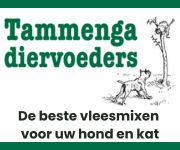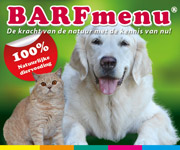Ik kwam laatst dit interessante stuk tegen over genetica en gedrag bij honden
Canine Behavioral Genetics. Het is een vrij lang stuk dat ook over de afstamming, andere hondachtigen, het gebruik van honden en overeenkomsten met de mens gaat.
Dit zijn een paar quotes mbt gedrag.
Consideration of other breeds defines an array of additional behaviors, such as such as pointing, retrieving, tracking, and drafting, that are presumably controlled, as least in part, by strong genetic components. In addition, dogs display an amazing range of emotions to which humans respond, including loyalty and affection, for which a genetic basis has often been postulated.
With recent completion of a 1.5× survey sequence of the standard poodle, a 7.5× high-quality draft sequence of the boxer and databases highlighting 2.1 million canine-specific single-nucleotide polymorphisms (SNPs), as well as the availability of platforms for doing whole-genome association studies, canine genetics is now poised to significantly advance our understanding of mammalian behavior. These facts, combined with increasing knowledge about how dog breeds relate one to another as well as how variation in the dog genome is organized allow us to hypothesize that we can unravel the genetic basis of both simple and complex canine behaviors with currently available tools. In the following sections, we first review dog domestication and describe ongoing experiments to identify behavioral genes. We discuss phenotypes of interest and highlight the features of the canine population that make it amenable to mapping studies. We also discuss what is known about genetic variation within the canine genome and how that may relate to behavioral genetics. Finally, we discuss examples of both normal and aberrant behaviors of interest to both human and companion-animal geneticists and the potential for identifying causative genes via the canine system.
Over de zilvervossen die geselecteerd werden op tamheid.
Yet, despite rigorous selection based solely on behavior, several morphologic traits that typically distinguish domestic dogs from their wild progenitors began to appear in the foxes including widened skulls, shortened snouts, floppy ears, shortened tails, curly tails, and altered coat color patterns. In aggregate, these data suggest a link between selection for behavior and generation of a subset of morphological traits observed in modern domestic dogs.
Perhaps the most striking behavioral variation observed in dogs is that observed across breeds. In their now classic study, Scott and Fuller examined interbreed differences in behavior in the American cocker spaniel, basenji, beagle, Shetland sheepdog, and wire-haired fox terrier. In general, dogs were reared in a standardized environment, although a subset was also cross fostered (across breed) to study the effect of maternal environment and some were reared in private homes to ensure that the performance of the laboratory animals was comparable to dogs in natural social settings.
The study revealed several interesting results. Specifically, the authors found that the cocker spaniel and Shetland sheepdog have much lower reactivity than the beagle, basenji, or wire-haired fox terrier. Reactivity relates to dogs' response to sudden changes in stimuli, such as a doorbell ring. They also found differences in trainability, depending on the specific task. One training task was learning the sit-stay command, which the cocker spaniel and wire-haired fox terrier learned much more quickly than the basenji, with the performance of the beagle and Shetland sheepdog falling in the middle. Breeds were also tested for problem-solving abilities with mazes, manipulation, spatial-orientation, detour, and trailing tests. Interestingly, no breed universally outperformed all the other breeds on all of the tests. Not surprisingly given the tasks, the beagle ranked first for speed of trailing a scent. The basenji ranked first for all the various manipulation tests of pulling strings and moving objects to reveal food items. Because of differences on a number of phenotypic axes, American cocker spaniels and basenjis were crossed to generate experimental, reciprocal backcross populations. F1 and F2 hybrids showed a strong tendency to be intermediate in performance on behavioral tests. Similarly, backcross progeny were intermediate relative to F1 and parental animals. In summary, although a limited number of breeds were characterized, the results of this work represents direct empirical evidence of the pronounced and reproducible behavioral diversity of the dog as well as the existence of genetic components of behavior.
Expression profiles of the amygdala were differentiated, but did not correlate with evolutionary distance or domestication. In contrast, gene expression in hypothalamus, which controls specific emotional and endocrinological responses, was highly conserved among the wild canids, yet divergent in the dog. Saetre et al.71 have postulated that behavioral selection for domestication may be the result of simple changes in gene regulation by genes in the hypothalamus.
Conclusions
For years the dog has been suggested as an ideal system for studies of behavioral genetics.79 With the genome now mapped and sequenced and tools for building haplotypes and studying expression at hand, it is time to tackle the hard experiments. Why is the basset hound less effective at herding sheep or an Anatolian shepherd less effective as a hunting dog? More importantly, why do Australian shepherd dogs herd and greyhounds chase, both in the absence of instruction? Why did the domestication of dogs lead to a level of loyalty and devotion unrivaled among modern mammals?
For many geneticists, the most interesting behaviors in dogs are those that are highly breed associated, such as herding and pointing. For others, the challenge is to understand the genetic variation that contributes to the individual variation between dogs (personality). Still others see in man's best friend a mirror of our best (loyalty, steadfastness, trainability, strong work ethic) and worst (stubbornness, aggression, and anxiety) qualities. An understanding of the genetics of all of these traits is likely to produce a better understand of not only the canine species, but the human species as well.







